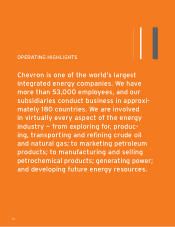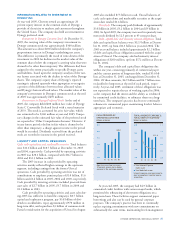Chevron 2005 Annual Report Download - page 31
Download and view the complete annual report
Please find page 31 of the 2005 Chevron annual report below. You can navigate through the pages in the report by either clicking on the pages listed below, or by using the keyword search tool below to find specific information within the annual report.
CHEVRON CORPORATION 2005 ANNUAL REPORT 29
Refer to pages 33 through 34 for additional discussion of
the company’s downstream operations.
Chemicals Earnings in the petrochemicals business are
closely tied to global chemical demand, industry inventory
levels and plant capacity utilization. Additionally, feedstock
and fuel costs, which tend to follow crude oil and natural gas
price movements, infl uence earnings in this segment.
Refer to page 34 for additional discussion of chemical
earnings for both the company’s Oronite subsidiary and the
50 percent-owned Chevron Phillips Chemical Company LLC.
OPERATING DEVELOPMENTS
Key operating developments and other events during 2005
and early 2006 included:
Upstream
Worldwide Proved Reserves As a result of the acquisition
of Unocal in August 2005, the company increased its net
oil-equivalent proved reserves by approximately 1.5 bil-
lion barrels. Signifi cant
unproved volumes of oil
and gas were also added
to the company’s resource
base. (Refer to pages 94
through 99 for a detailed
discussion of proved
reserve changes for 2005
and Note 2 beginning on
page 60 for a discussion of
the Unocal acquisition.)
North America In
September 2005, the
company sold Northrock
Resources Limited, a
wholly owned Canadian
subsidiary of Unocal, for
$1.7 billion. The disposi-
tion was consistent with
Chevron’s divestiture in
2004 of its conventional
crude oil and natural
gas business in western
Canada, enabling the
company’s continued
focus on the profi table growth of production of crude oil and
natural gas in strategically important core areas of operation.
In late 2005, the company began construction of the
fl oating production facility to be installed in the Tahiti
Field, in the deepwater Gulf of Mexico. Tahiti is anticipated
to have a maximum total daily production of 125,000 bar-
rels per day of crude oil and 70 million cubic feet of natural
gas. Chevron is the operator and holds a 58 percent working
interest in the project that is being developed in phases and
expected to come onto production in 2008.
In the same period, the decision was made to proceed
with the development of the Blind Faith Field, also in the
deepwater Gulf of Mexico. First production is expected in
2008, with initial total daily output estimated at 30,000
barrels of crude oil and 30 million cubic feet of natural gas.
Chevron is the operator and holds a 62.5 percent working
interest in the project.
In late 2005, the company drilled deepwater crude oil
discoveries in the Gulf of Mexico at the 60 percent-owned
and operated Big Foot prospect in the Walker Ridge Block
29 and the 25 percent-owned, nonoperated Knotty Head
prospect located in Green Canyon Block 512. Additional
appraisal activity continued into 2006 at both locations.
Angola In early 2006, fi rst oil was produced from the
31 percent-interest deepwater Belize Field in Block 14, off-
shore Angola. The Benguela, Belize, Lobito and Tomboco
fi elds form a project that is being developed in two phases.
The maximum total production from both phases of the
project is anticipated to reach 200,000 barrels of crude oil
per day in 2008.
Australia In mid-2005, the company won exploration
rights to four deepwater blocks in the northern Carnarvon
Basin offshore Western Australia. In early 2006, the com-
pany was awarded rights to another block in the Carnarvon
Basin. The blocks are located in an area of signifi cant natural
gas potential and near the Chevron-led Gorgon Project.
Chevron holds a 50 percent operated interest in the blocks.
Kazakhstan In late 2005, the company’s 50 percent-
owned Tengizchevroil (TCO) affi liate awarded commercial
contracts to enable increased crude-oil exports through a
southern route across the Caspian Sea. The southern route
will provide additional export capacity for TCO’s increased
production until the Caspian Pipeline Consortium pipeline
is expanded. The additional crude oil production at TCO
will result from major facilities-expansion projects being
constructed at a total cost of approximately $5.5 billion. By
the third quarter 2007, TCO’s crude production capacity is
projected to increase from the current capacity of 300,000
barrels per day to between 460,000 and 550,000.
Nigeria In early 2005, a construction contract was
awarded for the $1.1 billion fl oating production, storage and
offl oading (FPSO) vessel to be used at the Agbami Field. The
construction contract was a key milestone in the development
of the 68 percent-owned Agbami Field, which is scheduled to
come online in 2008 with an estimated maximum total daily
production of 250,000 barrels of crude oil.
Nigeria – São Tomé e Príncipe Joint Development Zone
(JDZ) In early 2005, the company signed a production-sharing
contract for Block 1 in the Nigeria – São Tomé e Príncipe JDZ.
Chevron will be the operator and has a 51 percent interest in
the block. Drilling of the fi rst exploration well was under way
in late-February 2006.
Venezuela In June 2005, the company discovered natural
gas in Block 3 of Plataforma Deltana, offshore Venezuela. The
site is in the proximity of the Loran natural gas fi eld in Block
2 and provides suffi cient resources for a detailed evaluation of
Venezuela’s fi rst liquefi ed natural gas (LNG) train.
In the third quarter 2005, the company was awarded an
exploration license for the Cardon III Block, offshore western
Venezuela. The block is in a region with natural gas potential
to the north of the Maracaibo producing area.
0.0
12.0
6.0
9.0
3.0
Net proved reserves for consolidated
companies climbed 10 percent in
2005, primarily due to the Unocal
acquisition.
*Barrels of oil-equivalent
NET PROVED RESERVES
Billions of BOE*
Other International
Asia-Pacific
Indonesia
Africa
United States
Affiliates
0201 03 04 05
9.0
2.9
























